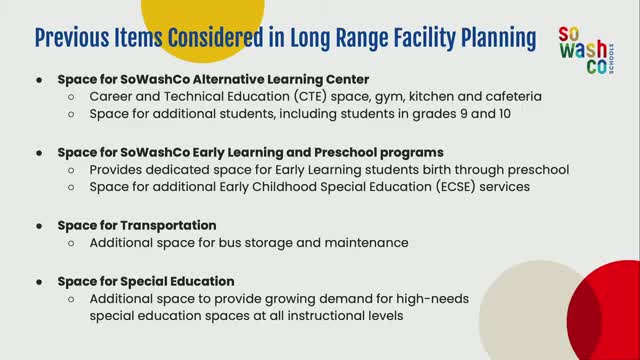District plans for land purchase to address school capacity and transportation needs
April 26, 2025 | South Washington County Schools, School Boards, Minnesota
This article was created by AI summarizing key points discussed. AI makes mistakes, so for full details and context, please refer to the video of the full meeting. Please report any errors so we can fix them. Report an error »

The South Washington County School Board convened on April 24, 2025, to address pressing issues regarding school capacity, enrollment trends, and future planning for the district. The meeting highlighted the ongoing challenges of managing waiting lists at elementary schools and the need for additional space to accommodate growing student populations.
The discussion began with a focus on the current waiting lists at most elementary schools, prompting the board to explore options for expanding facilities. The need for adequate transportation space was also emphasized, as the district aims to ensure that it has the necessary equipment and facilities to support student transportation needs.
Special education services were another key topic, with the board noting the success of a lease levy that has helped meet the needs of transition program students. However, there remains a significant opportunity to enhance services for K-12 students currently being contracted out. The board expressed a desire to provide these services within the district to better serve students and reduce reliance on external contracts.
The meeting also addressed the district's service center, which is currently operating in less-than-ideal conditions. The board acknowledged the need for a conducive working environment for staff and discussed the potential for land purchases to secure space for future educational needs, including early learning and alternative learning centers.
Athletic and performing arts facilities were reviewed, with board members noting that while current conditions are adequate, there is a need to catch up with neighboring districts that have made significant improvements to their facilities.
Dan Hines, a colleague of the board, presented an update on current enrollment realities, revealing that while secondary construction projects are expected to provide sufficient capacity for the next several years, there are approximately 2,000 empty seats at the elementary level. The board discussed the uneven enrollment trends across schools, with some experiencing growth while others remain under capacity.
The anticipated enrollment data indicated that five elementary schools are expected to exceed 90% capacity, while eight schools will remain below 80%. The board acknowledged the importance of monitoring these trends and considering potential adjustments to attendance boundaries in the future.
Looking ahead, the board plans to commission a new demographic report to better understand enrollment trends and their implications. They also aim to establish a consistent operating plan for early childhood education and continue to engage with the community through surveys to assess perceptions of district needs.
The meeting concluded with a commitment to ongoing evaluation of school capacities and the potential for future adjustments to address the challenges of enrollment and facility management. The board remains focused on ensuring that the district can effectively meet the needs of its students and families in the coming years.
The discussion began with a focus on the current waiting lists at most elementary schools, prompting the board to explore options for expanding facilities. The need for adequate transportation space was also emphasized, as the district aims to ensure that it has the necessary equipment and facilities to support student transportation needs.
Special education services were another key topic, with the board noting the success of a lease levy that has helped meet the needs of transition program students. However, there remains a significant opportunity to enhance services for K-12 students currently being contracted out. The board expressed a desire to provide these services within the district to better serve students and reduce reliance on external contracts.
The meeting also addressed the district's service center, which is currently operating in less-than-ideal conditions. The board acknowledged the need for a conducive working environment for staff and discussed the potential for land purchases to secure space for future educational needs, including early learning and alternative learning centers.
Athletic and performing arts facilities were reviewed, with board members noting that while current conditions are adequate, there is a need to catch up with neighboring districts that have made significant improvements to their facilities.
Dan Hines, a colleague of the board, presented an update on current enrollment realities, revealing that while secondary construction projects are expected to provide sufficient capacity for the next several years, there are approximately 2,000 empty seats at the elementary level. The board discussed the uneven enrollment trends across schools, with some experiencing growth while others remain under capacity.
The anticipated enrollment data indicated that five elementary schools are expected to exceed 90% capacity, while eight schools will remain below 80%. The board acknowledged the importance of monitoring these trends and considering potential adjustments to attendance boundaries in the future.
Looking ahead, the board plans to commission a new demographic report to better understand enrollment trends and their implications. They also aim to establish a consistent operating plan for early childhood education and continue to engage with the community through surveys to assess perceptions of district needs.
The meeting concluded with a commitment to ongoing evaluation of school capacities and the potential for future adjustments to address the challenges of enrollment and facility management. The board remains focused on ensuring that the district can effectively meet the needs of its students and families in the coming years.
View full meeting
This article is based on a recent meeting—watch the full video and explore the complete transcript for deeper insights into the discussion.
View full meeting
